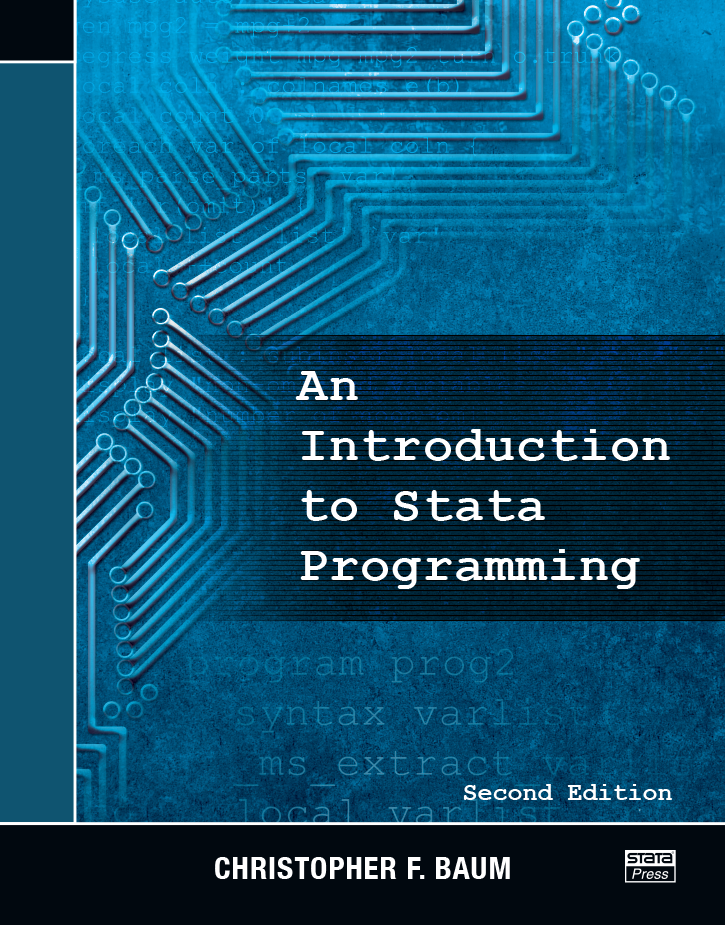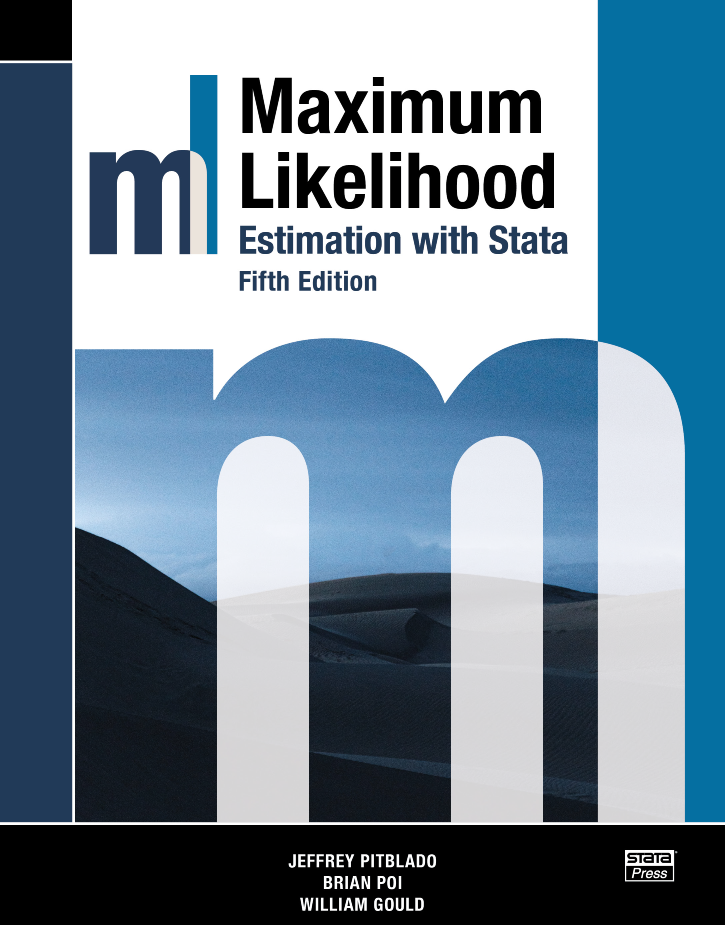
An Introduction to Stata Programming, Second Edition
96,000원
Author: Christopher F. Baum Publisher: Stata Press Copyright: 2016 ISBN-13: 978-1-59718-150-1 Pages: 412; paperback
Christopher F. Baum's An Introduction to Stata Programming, Second Edition, is a great reference for anyone who wants to learn Stata programming.
Baum assumes readers have some familiarity with Stata, but readers who are new to programming will find the book accessible. He begins by introducing programming concepts and basic tools. More advanced programming tools such as structures and pointers and likelihood-function evaluators using Mata are gradually introduced throughout the book alongside examples.
This new edition reflects some of the most important statistical tools added since Stata 10. Of note are factor variables and operators, the computation of marginal effects, marginal means, and predictive margins using margins, the use of gmm to implement generalized method of moments estimation, and the use of suest for seemingly unrelated estimation.
As in the previous edition of the book, Baum steps the reader through the three levels of Stata programming. He starts with do-files. Do-files are powerful batch files that support loops and conditional statements and are ideal to automate your workflow as well as to guarantee reproducibility of your work.
He then delves into ado-files, which are used to extend Stata by creating new commands that share the syntax and behavior of official commands. Baum gives an example of how to write a command to calculate percentiles and the range of a variable, complete with documentation and certification.
After introducing the fundamentals of command development, Baum shows users how these concepts can be applied to help them write their own custom estimation commands by using Stata's built-in numerical maximum-likelihood estimation routine, ml, its built-in nonlinear least-squares routines, nl and nlsur, and its built-in generalized method of moments estimation routine.
Finally, he introduces Mata, Stata's matrix programming language. Mata programs are integrated into ado-files to build a custom estimation routine that is optimized for speed and numerical stability. Baum briefly discusses how ado-file programming concepts relate to Mata functions and objects. He also explains some of the advantages of using Mata for certain programming tasks. Baum introduces concepts by providing the background and importance of the topic, presents common uses and examples, and then concludes with larger, more applied examples he refers to as “cookbook recipes”.
Many of the examples are of particular interest because they arose from frequently asked questions from Stata users. If you want to understand basic Stata programming or want to write your own routines and commands using advanced Stata tools, Baum's book is a great reference.
Christopher F. Baum is a Professor of Economics and Social Work at Boston College, where he codirects the undergraduate minor in scientific computation. Baum has taught econometrics for many years, using Stata extensively. He has over 40 years of experience with computer programming in a variety of languages and has authored or coauthored several widely used Stata commands over the past 12 years. He is the author of An Introduction to Modern Econometrics Using Stata, an associate editor of the Stata Journal, and a participant in many Stata Users Group meetings in the United States and Europe.
Ado-file programming
Mata programming for ado-files
1.2 Installing the necessary software
2.2.2 Locating important directories: sysdir and adopath
2.2.3 Organization of do-files, ado-files, and data files
2.4 Data types
2.4.2 Date and time handling
2.4.3 Time-series operators
2.4.4 Factor variables and operators
2.6 Protecting the data in memory: The preserve and restore commands
2.7 Getting your data into Stata
Free format versus fixed format
The import delimited command
Accessing data stored in spreadsheets
Fixed-format data files
2.8.2 Enhancing speed and efficiency
3.2.2 The numlist
3.2.3 The if exp and in range qualifiers
3.2.4 Missing data handling
Working with quoted strings
3.3.2 The cond() function
3.3.3 Recoding discrete and continuous variables
egen functions from the user community
3.7 Global macros
3.8 Extended macro functions and macro list functions
3.10 Matrices
4.2 Computing summary statistics over groups
4.3 Computing the extreme values of a sequence
4.4 Computing the length of spells
4.5 Summarizing group characteristics over observations
4.6 Using global macros to set up your environment
4.7 List manipulation with extended macro functions
4.8 Using creturn values to document your work
5.3 Reusing computed results: The return and ereturn commands
5.6 Combining datasets
5.7 Combining datasets with the append command
5.8 Combining datasets with the merge command
5.8.2 The dangers of many-to-many merges
5.9.2 The cross command
5.9.3 The stack command
5.9.4 The separate command
5.9.5 The joinby command
5.9.6 The xpose command
6.3 Handling time-series data effectively
6.5 Adding computed statistics to presentation-quality tables
6.6 Presenting marginal effects rather than coefficients
6.8 Using suest and gsem to compare estimates from nonoverlapping samples
6.9 Using reshape to produce forecasts from a VAR or VECM
6.10 Working with IRF files
7.2.2 The statsby prefix
7.2.3 The xi prefix and factor-variable notation
7.2.4 The rolling prefix
7.2.5 The simulate and permute prefixes
7.2.6 The bootstrap and jackknife prefixes
7.2.7 Other prefix commands
8.2 Calculating moving-window summary statistics
8.2.2 Calculating moving-window correlations
8.4 Requiring at least n observations per panel unit
8.5 Counting the number of distinct values per individual
8.6 Importing multiple spreadsheet pages
9.3 The post and postfile commands
9.4 Output: The export delimited, outfile, and file commands
9.5 Automating estimation output
9.6 Automating graphics
9.7 Characteristics
10.2 Computing marginal effects for graphical presentation
10.3 Automating the production of LATEX tables
10.4 Extracting data from graph files’ sersets
10.5 Constructing continuous price and returns series
11.3 The program statement
11.4 The syntax and return statements
11.5 Implementing program options
11.6 Including a subset of observations
11.7 Generalizing the command to handle multiple variables
11.8 Making commands byable
11.10 egen function programs
11.11 Writing an e-class program
11.13 Programs for ml, nl, nlsur
11.13.2 Programs for the nl and nlsur commands
11.15 Programs for the simulate, bootstrap, and jackknife prefixes
11.16 Guidelines for Stata ado-file programming style
11.16.2 Helpful Stata features
11.16.3 Respect for datasets
11.16.4 Speed and efficiency
11.16.5 Reminders
11.16.6 Style in the large
11.16.7 Use the best tools
12.2 Generalization of egen function pct9010() to support all pairs of quantiles
12.3 Constructing a certification script
12.4 Using the ml command to estimate means and variances
12.6 Generating a dataset containing the longest spell
12.7 Using suest on a fixed-effects model
13.2.2 Relational and logical operators
13.2.3 Subscripts
13.2.4 Populating matrix elements
13.2.5 Mata loop commands
13.2.6 Conditional statements
13.3.2 Access to locals, globals, scalars, and matrices
13.3.3 Access to Stata variables' attributes
13.5 Components of a Mata Function
13.5.2 Variables
13.5.3 Stored results
13.7 Example: st_interface function usage
13.8 Example: Matrix operations
13.10 Creating arrays of temporary objects with pointers
13.11 Structures
13.12 Additional Mata features
13.12.2 Associative arrays in Mata functions
13.12.3 Compiling Mata functions
13.12.4 Building and maintaining an object library
13.12.5 A useful collection of Mata routines
14.2 Shuffling the elements of a string variable
14.3 Firm-level correlations with multiple indices with Mata
14.4 Passing a function to a Mata function
14.5 Using subviews in Mata
14.6 Storing and retrieving country-level data with Mata structures
14.7 Locating nearest neighbors with Mata
14.8 Using a permutation vector to reorder results
14.9 Producing LATEX tables from svy results
14.10 Computing marginal effects for quantile regression
14.11 Computing the seemingly unrelated regression estimator
14.12 A GMM-CUE estimator using Mata's optimize() function




